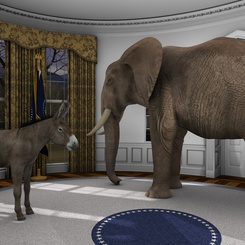With Estefania Santacreu-Vasut
From the paper “New avenues of research to explain the rarity of females at the top of the accountancy profession”, by Anne Jeny and Estefania Santacreu-Vasut, published in Palgrave Communication, March 2017.
___
Women rarely reach the top echelons of the Big Four audit firms: at KPMG, Deloitte, PwC, and EY, they represent only 10-20% of executives (i.e. partners). Why is this particular glass ceiling proving so hard to break? Existing explanations suggest either that women may just be “different”, or that they face societal-level barriers in terms of stereotypes and expectations.
While the Big Four are present in more than 140 countries, so far accounting research has focused on studying Anglo-Saxon countries or single country case studies. Economics research, on the other hand, has studied how gender roles and gender inequality varies across cultures. The nascent field of linguistic relativity and economics has recently emphasized that language may also play a role in shaping gender roles. Economics researchers have identified a correlation between gender distinctions in grammar (the feminine and masculine distinctions in French, for example) with lower socioeconomic, political, and managerial outcomes for women at country level.Findings further suggest that language may convey gender norms and provide a unique measure of historical gender roles that have been transmitted to the present day.
Our paper, “New avenues of research to explain the rarity of females at the top of the accountancy profession”, argues that the study of existing gender disparities in top leadership accountancy positions across countries may also benefit from using language to measure gender inequality. We substantiate our proposal by performing a thorough and systematic literature review on gender, accountancy and language (90 years of research, looking at papers from 1926 to 2016) and by collecting data on the presence of the Big Four throughout the world, including their linguistic environments and the characteristics of their global boards.
We find that the research that links gender in accountancy to the linguistic environment is scant and that the Big Four indeed operate in diverse linguistic environments. These findings allow us to suggest a set of avenues of future research, which we discuss in detail. We review existing explanations of the rarity of women in the Big Four and how these would change if we consider language.[1
“Just give it time”
The first explanation, “just give it time”, states that women lag behind because they entered the accounting profession later than men. This timeline may actually be country-specific because of varying histories of women in accounting. Therefore, it would be interesting to track the dynamic evolution of women who enter the accounting profession across countries as a function of the cultural and linguistic environment.
“Women are different”
The second explanation is that “Women are different”. These differences could be reflected in different preferences, regarding risk aversion or taste for competition, for example. Since language sex-based distinctions have been shown to correlate with gender roles and preference formation[2], the explanation that “Women are different” may be nuanced and enriched by considering the linguistic environment.
“Jobs are for the boys”
The third explanation, “Jobs are for the boys” establishes that women face barriers to entry into the accountancy profession. These barriers can be formal, such as inflexible working conditions. Kornberger, Carter and Ross-Smith (2010) have studied how the Big Four firms have undertaken major changes in its work organization to increase flexible working hours[3]. Their findings suggest that the discourse of organizations is as important as the actual policies in place because they shape both the actual barriers and the possible solutions to overcome them.
The barriers faced by women can also be informal and reflect culturally determined notions of masculinity and femininity. However, these notions vary across time and place. Gender inequality has been shown to be highest in countries where the grammar of the dominant language marks gender more intensively.[4] Incorporating the characteristics of the language that is spoken at the societal level may help researchers and accountancy firms to better understand the cultural obstacles that language may vehicle.
“A never-ending story?”
Finally, the explanation that discrimination is “A never-ending story?” perpetuated over time argues that expectations play an important role in maintaining gender roles in and outside organizations. Language may be one of the channels through which these expectations are conveyed.
To conclude, language may play an important role in perpetuating traditional gender roles, preventing women from accessing top leadership positions in society, as within the accountancy profession. Yet research linking gender in accountancy to the linguistic environment remains scant. Our findings suggest novel avenues for future research to revisit the existing explanations for gender inequality in the accounting profession.
[1] Dambrin C and Lambert C (2012) Who is she and who are we? A reflexive journey in research into the rarity of women in the highest ranks of accountancy. Critical Perspective on Accounting; 23 (1): 1–16.
[2] Hicks DL, Santacreu-Vasut E and Shoham A (2015) Does mother tongue make for women’s work?
[3] Kornberger M, Carter C and Ross-Smith A (2010) Changing gender domination in a big four accounting firm: Flexibility, performance and client service in practice. Accounting, Organizations and Society; 35 (8): 775–791.
[4] Gay V, Santacreu-Vasut E and Amir S (2013) The Grammatical Origins of Gender Roles, Berkeley Economic History Lab Working Paper 2013-03, http://behl.berkeley.edu/wp/2013-03.









